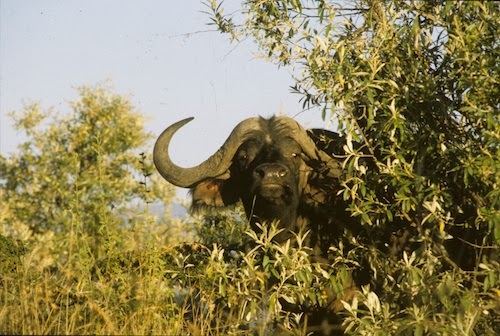 |
| One of Amman's many pictures of the bushmeat trade |
Of course writers with bigger followings, like the remarkable Karl Amman have written and photographed bushmeat and poaching stories to a wide audience. He also graciously allowed me to use some of his images in my book The Trouble With Lions .
The late Anna Mertz, who worked as an engineer in West Africa for many years reported on the horror show of truck loads of dead and badly injured antelopes appearing almost in food markets in Ghana long before the bushmeat trade issue reached a wider global audience.
My steward acquaintance told me that loads of bushmeat continue to come out of Africa bound for the UK with every flight. It is packed in passenger luggage, and the security officers who check bags before departure have no interest in, and probably no jurisdiction over it. They are concerned with weapons.
The airplane staff can do little about it either. They do try to curtail the excess baggage situation, but even that is a hopeless task, as the routine response from Nigerian passengers is that a white-skinned staff member is picking on a black person. Inevitably some of the bags leak their contents and many planes end up with bloodstains and bad smells.
In Kenya Ann Olivecrona told me how she chanced to witness a bushmeat import at London’s Heathrow airport. As I wrote in 2008:
“in May 2004 she witnessed an amazing interchange involving bushmeat at London’s Heathrow airport. Her plane happened to arrive at more or less the same time as a flight from Lagos. During the time that she watched the procession, customs officials stopped every one of the Nigerian passengers and asked for the huge suitcases to be opened. Almost all were packed with smoked bushmeat.”
The bushmeat trade poses serious risks at both ends.
In Africa it is leading the rapid depletion of wildlife populations. Many species are involved. While primates are the most evocative for most people, the most popular species is the cane rat of the genus Thryonomys, known locally as cutting grass. They can weigh as much as 10 kg in the wild and in most West Africa countries efforts have been made to rear them for the meat market.
 |
| Credit: Aurélia Zizo/Wikipedia |
Here is a picture from the Wiki of one such rat, a male Greater Cane Rat (Thryonomys swinderianus) in a breeding station in Owendo, Gabon.
Many tribes in the region have long held certain species taboo. Not any more. Anything goes. One example is the African buffalo, long deemed off limits to one clan in Ghana. In October 2001 Ghanaian journalist Vivian Baah wrote a series of articles under the title “Guess What’s Cooking for Dinner?” in the Evening News of Accra. She related how in parts of Ghana:
“among the Ekona clan of the Ashanti's, it is a taboo to kill the Ekuo (buffalo). But these days, the members of this clan themselves are the worst offenders. Having turned their backs on the taboo, they now butcher the Ekuo with cheeky ease.”
 |
| Cape buffalo - aka Ekuo in Ghana |
Of course this process will inevitably lead to the law of diminishing returns. Species will simply disappear or become rare.
In Europe there are serious disease risks. Much of the continent has an endemic foot-and-mouth disease status. If the disease gets into UK, for instance, it will cause billions of dollars worth of economic damage. All it needs is for some improperly preserved meat to carry the virus to destination. A little bad luck or carelessness and the explosion would take place. If this seems unlikely one only has to look at my home province of Saskatchewan, where, in 1952, illegally imported smoked meat from Poland led to the last outbreak of FMD.
 |
| Fruit bats roositng in Uganda |
No comments:
Post a Comment